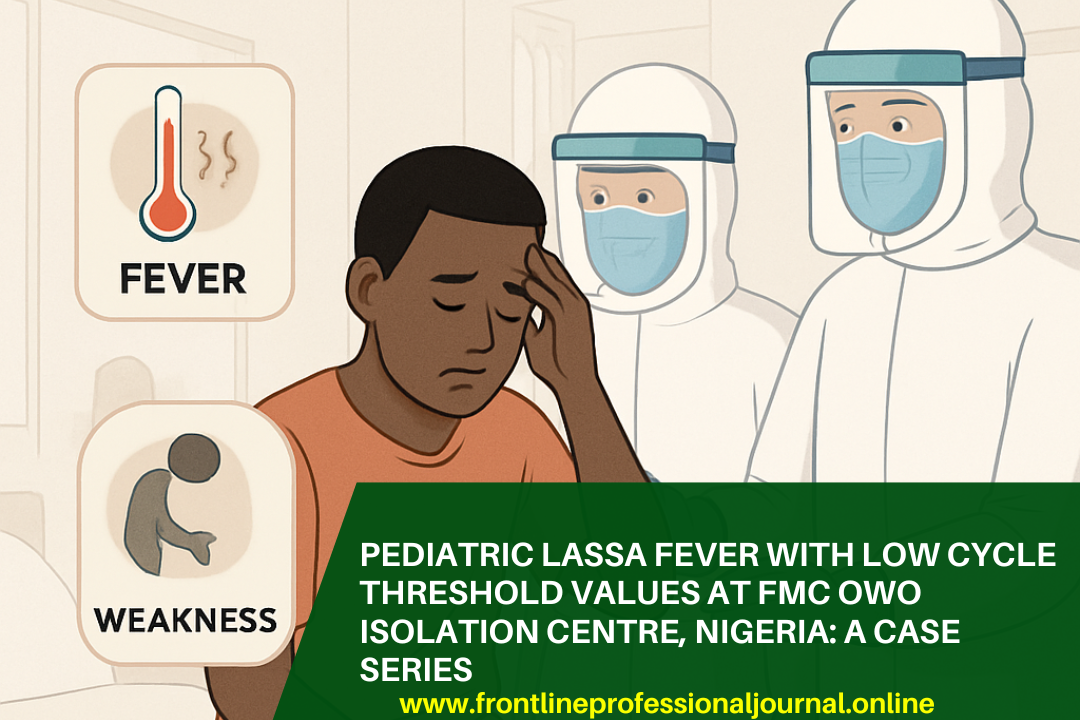
Authors: Isaac Ihinmikaye, Chinonso Emmanuel Amadi, Ifedayo Olabisi Fasoranti, Temitope Emmanuel Taiwo, Olufemi Oladele Ayodeji
CITATION: Isaac Ihinmikaye, Chinonso Emmanuel Amadi, Ifedayo Olabisi Fasoranti, Temitope Emmanuel Taiwo, Olufemi Oladele Ayodeji (2025). Pediatric Lassa fever with low cycle threshold values at FMC Owo isolation centre, Nigeria: A case series. Frontline Professionals Journal 2(11), 207-214
ABSTRACT
Lassa fever is a zoonotic viral hemorrhagic disease endemic in West Africa region. It remains a major public health concern with Nigeria reporting most of the global cases. The reverse transcriptase polymerase chain reaction (RT-PCR) cycle threshold (CT) value is a key indicator of viral load and has been strongly linked to disease severity and poor outcomes in adults. However, little evidence exists about its prognostic significance in children, whose immune responses and recovery patterns may differ. This case series presents pediatric patients with very low CT values who nonetheless achieved full recovery following comprehensive care, challenging existing assumptions about CT values and outcomes. We reviewed the clinical profiles of three children with laboratory-confirmed Lassa fever admitted to the Federal Medical Centre (FMC) Owo Isolation Centre, Nigeria. Each received intravenous ribavirin according to national treatment protocols, alongside intensive supportive care including blood transfusions, antimicrobials, anticonvulsants, oxygen therapy, and organ support as indicated. CT values for the L and G genes were recorded at baseline and monitored during treatment. All cases were co‑managed with the Pediatricians throughout admission, and received IV ribavirin in line with NCDC protocols, together with supportive care (transfusions, antimicrobials, anticonvulsants, oxygen therapy and targeted organ support as required). RT‑PCR CT values (reported here as G and L genes where available) were recorded at baseline and during follow‑up as part of routine clinical monitoring. Clinical data, laboratory values and documented interventions were extracted from inpatient records.
The study reported three pediatric cases of laboratory-confirmed Lassa fever managed at FMC Owo Isolation Centre, Nigeria. A 1-year-old female (baseline G18.89 and L23.37) developed seizures, anemia, and multi-organ dysfunction but recovered and discharged 31 days later following ribavirin administration, blood transfusion, and other supportive care. An 8-year-old male (baseline G-14.99 and L-19.23) experienced seizures, bleeding from puncture sites, and prolonged illness, yet was discharged after 23 days of intensive management. A 10-year-old male (baseline G-23.99 and L-27.56), had a comparatively mild course with anemia and hematuria, achieving full recovery within 16 days. In all cases, rising CT values during treatment paralleled clinical improvement.
This is one of the first pediatric-focused Lassa fever case series linking CT values with outcomes. CT monitoring shows promise both as a baseline prognostic marker and as a dynamic indicator of treatment response. Hence, CT monitoring should be interpreted with caution in pediatric cases. Larger studies are needed to validate pediatric-specific cut-offs and inform triage and resource allocation in endemic settings. The findings suggest that, unlike in adults, low CT may not invariably predict poor outcomes in children. Instead, it may serve as a marker of disease severity that improves with timely antiviral therapy and multidisciplinary supportive care.








